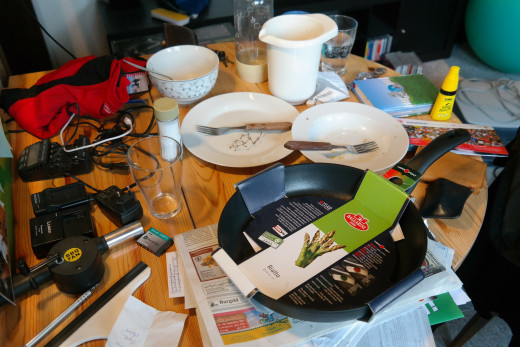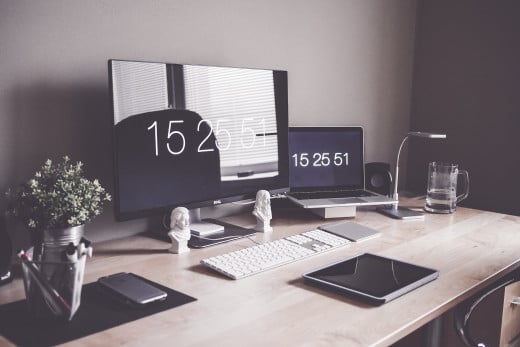How to Avoid Filling Your House with Clutter
Are you frustrated that the clutter has returned?
Whether in the past you’ve decluttered your closet, your kitchen, or your entire home, you probably met the frustration of watching the clutter return. One day your kitchen counters and dining table were clear and then the next day piles of stuff seemed to have magically appeared.
Chances are that you’ve paused and wondered things like, “Where did all this stuff come from?” and “What is all this stuff?”
Clutter is too much stuff in the wrong place

A little bit of effort every day will maintain order
Staying organized is about your mindset and a few simple daily actions.
The biggest misconception about decluttering
Some professional organizers and minimalists suggest that if you’ve decluttered the right way then you’ll stay organized for life. But decluttering is only part of the story.
Decluttering gives you less stuff and makes it easier to clean and maintain order in your home. Note the emphasis on the word maintain. Whether you have 100 items or 1,000 in a space after you’ve decluttered, you need to keep things organized and that requires some simple, mostly daily, actions that you can do even before you start decluttering.
Keep what you own organized
Part of avoiding clutter involves maintaining order.
Stay organized by controlling your stuff
Notice what fits in a space. That bookshelf is built to hold only so many books. Once you start cramming in additional titles, making it more difficult to find and remove the book you want, you have too many books. If the hangers in your closet can’t slide along the clothing rod, then you have too many clothes hanging in that space and it’s more challenging to see what you own.
Now, the solution isn’t to take the stuff that doesn’t fit in one space and move it someplace else or to buy more organizing storage items.
Use the limitations of what can fit in a space as your guide for when it’s time to declutter some items. Cramming things into a space makes the area look cluttered because there’s too much stuff.
Get in the habit of “resetting the room." This refers to putting things away when you are done with a space. For example, clearing the surface of your desk at the end of the day, making your bed, cleaning the kitchen and putting away everything that you used to make a meal, folding the afghan and plumping the pillows on the couch after watching a movie.
The reason to reset the room is so that when you return to the space it’s ready and welcoming. You won’t have to clean a sink full of dishes and move things off the counter before you can make breakfast.
Do an end of the day tidy - If you get into the habit of resetting a room when you are done in that space, then you won’t have much clutter to deal with at the end of the day.
An end of the day tidy basically involves walking from room-to-room and picking up anything that belongs in another space. So, the mug on your desk will go into the dishwasher, the coat you threw over the back of a chair will get hung in the coat closet, the day’s mail will go into recycling or to the inbox on your desk so you can act on or file those papers.
Tidying isn’t cleaning. You aren’t dusting, vacuuming, or taking out the trash. Tidying is putting things where they belong.
Maintaining order requires less effort than you may think

Watch what stuff comes into your home
Another part of avoiding clutter is limiting what enters through your front door.
Watch what you bring into your home so you don't create new clutter
Avoid “stocking up” just because something is on sale - If you don’t have any pasta in your house and you buy a box or two to keep in your pantry, you’ll be all set for a meal or two. However, if you go to the store and see that pasta is on sale and you stock up by buying ten boxes, you now need to find space for ten boxes of pasta, that may last you two or three months.
If, in a month, you see pasta on sale again, you may think, “Oh, I’ve been serving pasta at dinner and it’s on sale, so I should buy more.” Then you get home and see that you already had five boxes in your pantry.
You squeeze in the boxes here and there, which means you’ll likely lose track of just how many boxes you have tucked into this space. Your pantry shelves become disorganized and cluttered and you might not be using your oldest products.
Although this example is about food, it could be about paper towel, toilet paper, cleaning products, shampoo, etc. Stores often encourage you to stock up, but remember they aren’t helping you; they’re adding to their profits.
Decide how much you really need to keep on hand.
Watch your impulse buys - Be aware of purchasing things like books, shoes, craft supplies, or items that promise to make daily actions easier (meal prep items, grooming and exercise gadgets).
I’m not suggesting that you can never buy something new, but each time you add something to your home, consider getting rid of an item so the number of items in a space stays in balance. So, if you buy a new pair of shoes, then you’ll donate another pair of shoes.
All of this goes back to noticing that spaces can only hold so much stuff before the area becomes crowded and cluttered looking.
So, get in the habit of releasing one item for every new thing you buy. If you need to declutter, you can create a rule of getting rid of ten items for every new thing you buy. That rule can help you both declutter, and it will make you think twice before making a purchase.
Ask for experience gifts instead of physical objects - Unless you want to receive a particular item as a gift, consider asking family and friends for experience gifts – a class through your local community center or an online site; a gift card for a meal at a restaurant, a massage, or a pedicure; tickets for an event; a day at a museum, etc.
You’ll get to keep the fantastic memories without adding stuff to your home.
Experiences add no clutter to your home

Be proactive and you'll keep the clutter away
Notice that except for resetting the room and doing an end of the day tidy up, most of these actions take very little time. Even doing an end of the day tidy up doesn’t have to take more than 10 or 15 minutes.
What really keeps the clutter away is being more mindful and aware of limiting what comes into your home as well as avoiding allowing things to pile up around your home. A few minutes of attention every day will save you from a disorganized home.
© 2020 Susan Caplan McCarthy








